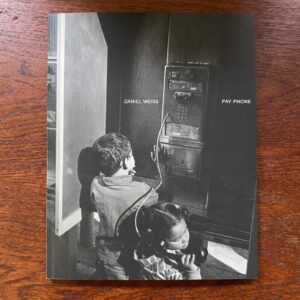JTF (just the facts): Self-published in October 2018 (here). Hardcover, 152 pages, with 84 color photographs. In an edition of 1000 copies. Design by Letícia Lampert. (Cover and spread shots below.)
Comments/Context: Letícia Lampert is a Brazilian artist with a background in graphic design, photography, and architecture. As an artist, Lampert is interested in cultural identity and architecture, and how physical space defines our experiences. In her earlier series Random City, she collaged photographs from several cities (New York City, São Paulo, Buenos Aires, and Adelaide) into single images; and while the mix of pictures was intentionally obvious, the result is an intriguingly continuous city landscape. In her latest series, Lampert “investigates how the same city could be perceived as a different place when seen from different people’s eyes.” She decided to examine the views people have from their apartment windows, in neighborhoods where opposite building blocks are situated very close to each other.
All of the photographs in the series were taken in Porto Alegre, the capital and largest city of the Brazilian state of Rio Grande do Sul. Lampert took the pictures in a middle class neighborhood in the downtown area, and her primary criteria for the project was the proximity of the buildings and their opposing windows. Her first visits were scheduled with the help of building managers (she calls them “project curators”). Walking around the area with her camera and tripod also helped to start conversations with the residents. Gaining their trust, and ultimately receiving invitations into their apartments, Lampert would visit their homes and take photographs of the buildings across the way, as seen from the windows.
Lampert recently self-published the project in a photobook titled Known By Sight. An image of a close up fragment of a building fills the book cover: we see a plant and a satellite dish on one balcony and drying clothes on the one above. The title of the book is almost invisible, as it is embossed on the dark area of the photograph. The book has a hard cover, yet inside it is constructed as an accordion, assembling all of the photographs into a continuous visual flow.
The photographs begin right from the end papers. Each segment depicts part of a building as seen from the window across. The images are framed to capture only building units, without street life or the sky. There are facades of various painted colors (white, yellow, pink, grey, etc), balconies (with decorative railings, with plants and chairs, or just empty), brickwork, pipes, air conditioners, and, of course, windows. The images are rigorously squared off, so the formal patterns and repetitions in the architecture become more obvious. As the pages turn, the geometries take over, that is until the windows offer insights into the residents’ lives. Occasionally we see people (and their pets) looking out of the windows, standing on the balconies, hanging clothes to dry, eating dinner, and, naturally, cleaning their windows. The accordion construction ends with an image of an apartment interior facing the window, taking us to the beginning of the next chapter.
The other side of the accordion reveals the interiors of the apartments. There are cozy living rooms, messy bedrooms, dining tables, and comfortable sofas, often seen in dark shadow. The view from inside suddenly makes it painfully obvious just how close the other buildings are. This juxtaposition of outside and inside, light and dark, both in terms of building viewpoint and book construction, creates a playful and exciting experience, as our curiosity pushes us to match the images on both sides. The pictures shot in the apartments are accompanied by the texts documenting the residents’ impressions and comments about their neighbors. These residents, in most cases complete strangers, live in close proximity, almost unavoidably observing each other’s daily routines.
There no portraits of the residents, but their voices appear along with the photographs of their apartments. They reveal a wide range of emotions: curiosity, concern, suspicion, empathy. One person worries about an old lady, and feels relief every morning the neighbour starts her daily routine. Another resident, identified as C. from 71, says they pull the curtains while watching TV, to stay private “because you never know who is on the other side.” Other people get used to each others’ presence through the window: “A woman lived by herself in that one. So, it was like we had a relationship without actually having one. Because she didn’t mind walking around in her pajamas, wearing nothing but a t-shirt or wrapped in a towel.” We might imagine that such close proximity would be a negative thing – an invasion of privacy or a feeling on constant intrusion or surveillance – but these commentaries reveal a more complex and communal picture of the relationships formed between the residents living side-by-side.
The design and accordion construction of the book, with its continuous movement of images, smartly reflects the sense of tight space Lampert is investigating. The photographs don’t necessarily stand out on their own, but brought together inside this clever structural two-sided framework, they create an engaging back and forth narrative. Known By Sight is memorable because it uses the strengths of the photobook form to thoughtfully consider these spatial realities and connective forces, unpacking the subtle relationships of urban living.
Collector’s POV: Letícia Lampert is represented by Galeria Mamute in Porto Alegre (here). Her work has little secondary market history at this point, so gallery retail likely remains the best option for those collectors interested in following up





























